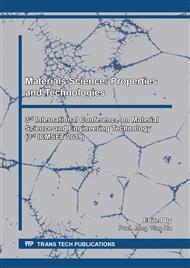[1]
J. F. Ayala-zavala, V. Vega-vega, C. Rosas-Domínguez, H. Palafox-Carlos, J. A. Villa-Rodriguez et al. Agro-industrial potential of exotic fruit byproducts as a source of food additives, Food Res. Int. 44(7) (2011) 1866-1874.
DOI: 10.1016/j.foodres.2011.02.021
Google Scholar
[2]
L. M. Ribeiro da Silva, E.A. Teixeira de Figueiredo, N.M. Pontes Silva Ricardo, et. al. Quantification of bioactive compounds in pulps and by-products of tropical fruits from Brazil, Food Chem. 143 (2014) 398-404.
DOI: 10.1016/j.foodchem.2013.08.001
Google Scholar
[3]
S. M. A. Razavi, E. Milani, Some physical properties of the watermelon seeds, Afr. J. Agric. Res. 1(3) (2006) 65-69.
Google Scholar
[4]
H. Ç. Kaymak, The relationships between seed fatty acids profile and seed germination in cucurbit species, Žemdirbystė=Agric. 99(3) (2012) 299-304.
Google Scholar
[5]
S. Lagha-Benamrouche, K. Madani, Phenolic contents and antioxidant activity of orange varieties (Citrus sinensis L. and Citrus aurantium L.) cultivated in Algeria: Peels and leaves, Ind. Crops Prod. 50 (2013) 723-730.
DOI: 10.1016/j.indcrop.2013.07.048
Google Scholar
[6]
D. R. Kammerer; J. Kammerer, R. Valet, R. Carle, Recovery of Polyphenols from the by products of Plant Food Processing and Application as Valuable Food Ingredients, Food Res. Int. 65 (2014) 2-12.
DOI: 10.1016/j.foodres.2014.06.012
Google Scholar
[7]
J. G. Rodríguez-Carpena, D. Morcuende, M. Estévez, Avocado by-products as inhibitors of color deterioration and lipid and protein oxidation in raw porcine patties subjected to chilled storage, Meat Sci. 89(2) (2011) 166-173.
DOI: 10.1016/j.meatsci.2011.04.013
Google Scholar
[8]
M. E. Pahua-Ramos, A. Ortiz-Moreno, G. Chamorro-Cevallos, et. al., Hypolipidemic effect of avocado (Persea americana Mill) seed in a hypercholesterolemic mouse model, Plant Foods Hum. Nutr. 67(1) (2012) 10-16.
DOI: 10.1007/s11130-012-0280-6
Google Scholar
[9]
B. A. Schaffer, B. N. Wolstenholme, A. W. Whiley, Introduction in B. A. Schaffer, B. N. Wolstenholme, A. W. Whiley (Eds), The avocado: botany, production, and uses, CABI, DOI 10.1079/9781845937010.0000 (2013) pp.1-9.
DOI: 10.1079/9781845937010.0000
Google Scholar
[10]
J. B. Bost, N. J. H. Smith and J. H. Crane, History, Distribution and Uses, in B. A. Schaffer, B. N. Wolstenholme, A. W. Whiley (Eds), The avocado: botany, production, and uses, CABI, DOI 10.1079/9781845937010.0000 (2013). pp.10-30.
DOI: 10.1079/9781845937010.0000
Google Scholar
[11]
E. Padilla-Camberos, M. Martínez-Velázquez, J. M. Flores-Fernández, S. Villanueva-Rodríguez, Acute toxicity and genotoxic activity of avocado seed extract (Persea americana Mill., c.v. Hass), Sci. World J. 2013 (2013).
DOI: 10.1155/2013/245828
Google Scholar
[12]
M. L. Dreher, A. J. Davenport, Hass avocado composition and potential health effect, Crit. Rev. Food Sci. Nutr. 53(7) (2013) 738-750.
DOI: 10.1080/10408398.2011.556759
Google Scholar
[13]
A. Kosińska, M. Karamać, I. Estrella, T. Hernández, B. Bartolomé, G. A. Dykes, Phenolic compound profiles and antioxidant capacity of Persea americana Mill. peels and seeds of two varieties, J. Agric. Food Chem. 60(18) (2012) 4613-4619.
DOI: 10.1021/jf300090p
Google Scholar
[14]
M. A. Ortiz, A. L. Dorantes, M. J. Gallndez, S. E. Cárdenas, Effect of a novel oil extraction method on avocado (Persea americana Mill) pulp microstructure, Plant Foods Hum. Nutr. 59(1) (2004) 11-14.
DOI: 10.1007/s11130-004-0032-3
Google Scholar
[15]
M. R. Ramos, G. Jerz, S. Villanueva, F. López-Dellamary, R. Waibel, P. Winterhalter, Two glucosylated abscisic acid derivates from avocado seeds (Persea americana Mill. Lauraceae cv. Hass), Phytochemistry, 65(7) (2004) 955-962.
DOI: 10.1016/j.phytochem.2003.12.007
Google Scholar
[16]
J. G. Rodríguez-Carpena, D. Morcuende, M. J. Andrade, P. Kylli, M. Estevez, Avocado (Persea americana Mill.) phenolics, in vitro antioxidant and antimicrobial activities, and inhibition of lipid and protein oxidation in porcine patties, J. Agric. Food Chem. 59(10) (2011) 5625-5635.
DOI: 10.1021/jf1048832
Google Scholar
[17]
O. N. Anaka, R. I. Ozolua, S. O. Okpo, Effect of the aqueous seed extract of Persea americana Mill (Lauraceae) on the blood pressure of Sprague-Dawley rats, Afr. J. Pharm. Pharmacol. 3(10) (2009) 485-490.
DOI: 10.4314/ajtcam.v6i4.57214
Google Scholar
[18]
A. Jimenez-Arellanes, J. Luna-Herrera, R. Ruiz-Nicolas, J. Cornejo-Garrido, A. Tapia, L. Yépez-Mulia, Antiprotozoal and antimycobacterial activities of Persea americana seeds, BMC Complement. Altern. Med. 13 (2013) article 109.
DOI: 10.1186/1472-6882-13-109
Google Scholar
[19]
R. B. Maseko, C. M. Nkambule, MB. Botha, Synthesis of authentic organic standards of antibacterial compounds isolated from avocados, Tshwane University of Technology, Department of Chemistry and Physics Faculty of Natural Sciences, (2006) 1-4.
Google Scholar
[20]
J. J. Leite, E. H. Brito, R. A. Cordeiro, R S Brilhante et al. Chemical composition, toxicity and larvicidal and antifungal activities of Persea Americana (avocado) seed extracts, Rev. Soc. Bras. Med. Trop. 42(2) (2009) 110-113.
DOI: 10.1590/s0037-86822009000200003
Google Scholar
[21]
D. Dabas, R. M. Shegog, G. R. Ziegler, J. D. Lambert, Avocado (Persea americana) seed as a source of bioactive phytochemicals, Curr. Pharm. Des. 19(34) (2013) 6133-6140.
DOI: 10.2174/1381612811319340007
Google Scholar
[22]
U. Emmanuel Uchenna, A. Bakr Shori, A. Salihin Baba, Inclusion of avocado (Persea americana) seeds in the diet to improve carbohydrate and lipidmetabolism in rats, Rev. Argent. Endocrinol. Metab. 54(3) (2017) 140-148.
DOI: 10.1016/j.raem.2017.07.005
Google Scholar


